Bluehead
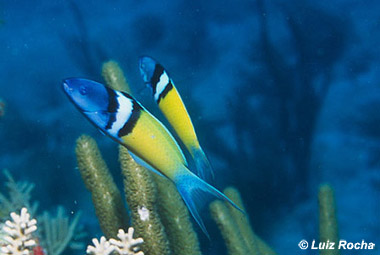
Thalassoma bifasciatum
This schooling reef fish has a varied assortment of color patterns based on its life phase and behavior. It gets its name from the final phase where it has a bright blue head followed by black and white bars and then a green or blue-green body with a gold sheen. The final phase is achieved by only a small percentage of males, or females who become males in the absence of males. They are social fish that school in the hundreds or thousands in shallow reef zones, and are valued as cleaners, removing parasites and dead tissue from other fish.
Order – Perciformes
Family – Labridae
Genus – Thalassoma
Species – bifasciatum
Common Names
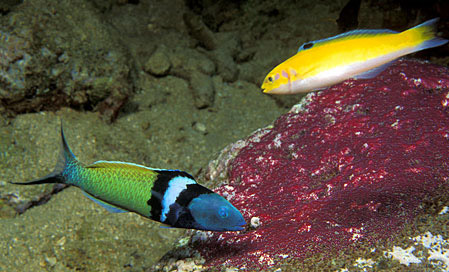
English language common names are bluehead, blue head, blue mah, bluehead wrasse, doctor fish, parrotfish, and tikitiki. Common names in other languages include bayan (Malay), blaukopflippfisch (German), cara de cotorra (Spanish), loro cabeza azul (Spanish), and talasoma sinoglowa (Polish).
Importance to Humans
The bluehead is of no interest to fisheries due to its very small size and poor edibility. However their beautiful coloration and hardiness make them popular in the aquarium trade. They are bold and often approach scuba divers and snorkelers.
Conservation
The bluehead is not considered as endangered or vulnerable with the World Conservation Union (IUCN). The IUCN is a global union of states, governmental agencies, and non-governmental organizations in a partnership that assesses the conservation status of species.
> Check the status of the bluehead at the IUCN website.
Geographical Distribution
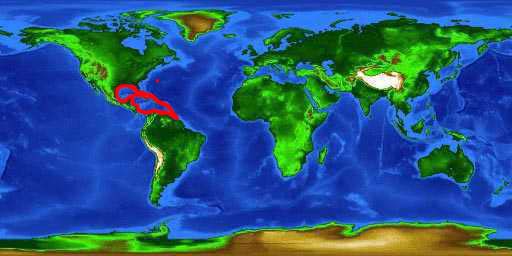
The bluehead is found in the western Atlantic Ocean from Florida (U.S.) to the Bahamas, Caribbean Sea, Gulf of Mexico and south to northern South America. It also occurs in Bermuda and is most abundant throughout the West Indies.
Habitat
Although it is found almost any place where water clarity is high, choice habitat for the bluehead includes coral reefs, rocky flats, sandy bottoms, and seagrass. It swims about the reef constantly and is found at depths to over 100 feet (30.5 m). This fish is most abundant on shallow reefs, sometimes occurring in schools of thousands of individuals foraging along the bottom or feeding on plankton from the water column. Juveniles often seek shelter among the tentacles of sea anemones, deliberately avoiding direct contact. If stung by the tentacles, it will be ingested by the anemone.
Biology
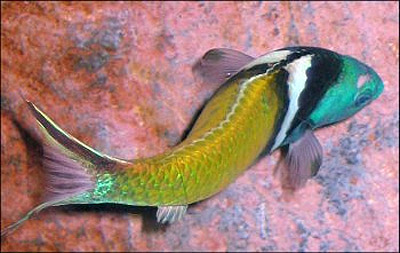
Distinctive Features
The body is elongate with a depth of approximately 3.5 inches (9 cm), similar in appearance to a compressed cigar. The snout is blunt. Young males and all females have a caudal fin that is truncate to slightly rounded while supermales have a lunate caudal fin. In contrast to most fishes, the bluehead swims with its pectoral fins, appearing to drag its tail.
Coloration
This is an attractive fish with a variety of color phases. The supermale, or terminal phase (TP) male, has a scaleless bright blue head followed by two dark vertical stripes separated by a white bar. The remainder of the body is green to blue-green. Caudal fins have black lobes and the pectoral fins are edged with black. Supermales make up only 4% of the population.
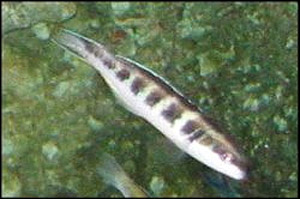
Small males and females (initial phase (IP)) look similar to juveniles except the mid-lateral stripe is broken into a series of blotches ranging from dark to very faint. IP blueheads also display two other color variations. One has a yellow head and body above the white underside, with two square-like spots behind the eye and not mid-lateral stripe. The other has white bars that break up the mid-lateral stripe into a series of blotches and the back is yellowish to greenish-blue in color. IP fish are capable of changing from one color pattern to another with an intermediate coloration.
The juvenile phase has a black mid-lateral stripe. Those individuals that live among coral reefs are yellow above this stripe while inshore, non-reef associated fish are white. The area below the stripe is white in both inshore and offshore fishes.
These fish resemble the wrasse blenny (Hemiemblemaria simulus), however it is distinguishable by a spot behind the second dorsal ray that extends to the base of tail. The wrasse blenny has a spot behind the third dorsal ray that does note extend to the base of caudal fin. The juvenile tiger grouper (Mycteroperca tigris) mimics the initial phase bluehead. By mimicking a non-predatory, common fish, the tiger grouper is able to closely approach potential prey. Another advantage is the juvenile tiger grouper experiences reduced predation pressure as it mimics parasite cleaners that are avoided by some predators.
Size, Age, and Growth
Blueheads reach a maximum length of 9.8 inches (25 cm), with a maximum reported age of 3 years. Individuals reach sexual maturity at lengths as small as 1.5 inches (3.8 cm).
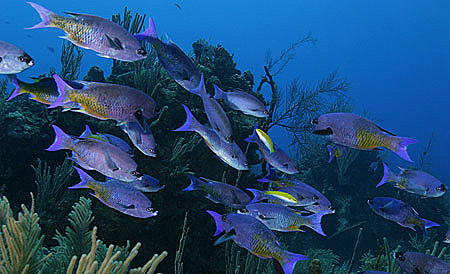
Dentition
Two canine teeth are located on the upper and lower jaws and a single row of conical teeth on the margin of both jaws that become progressively longer toward the front of the mouth.
Food Habits
Adult blueheads feed primarily on zooplankton and many small benthic organisms. They are also known to eat the eggs of other small fish including the saddle blenny (Malacoctenus triangulatus), beaugregory damselfish (Stegastes leucostictus), and sergeant majors (Abudefduf saxatilis).
IP blueheads are on the most successful cleaner fish in the western Atlantic Ocean. They set up “cleaning stations”, providing an important service to other reef fish by “cleaning” the ectoparasites and dead tissues off their skin and scales. The blueheads receive nutrients from these parasites and tissues, thereby creating a symbiotic relationship. The cleaning wrasse advertises these services by performing a dance to attract would-be customers. When a fish is interested in being cleaned, it also sends specific signals to the wrasse such as holding its mouth open and spreading its fins. During this cleaning, the wrasse removes parasites from the fins and gills as well as inside the mouth and between the teeth.
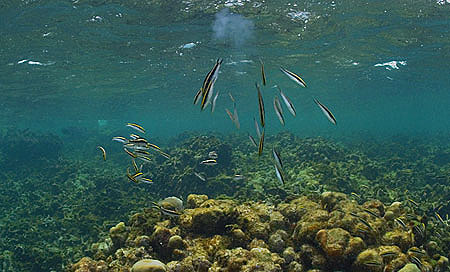
Reproduction
Spawning occurs throughout the entire year. At midday blueheads find each other, with the smaller yellow IP fishes releasing eggs and sperm in large groups. Large numbers of these IP fish swim a few feet above the bottom substrate, then in mass they dash upwards into the water column above. At the peak of this dash, all fish release sperm or eggs. Following such an event, a cloud of gametes is sometimes seen drifting off with the prevailing water currents. The larger blueheads spawn in pairs with a single female and a single male. The dominant TP males form harems, spawning with one female at a time. He stakes out a prominent spawning site from which he courts females. This courtship includes approaching females while displaying the dashing motion, similar to the group spawning rush behavior. If the female is receptive, she joins him in a dash towards the surface for the release of eggs and sperm. TP males may spawn with up to 100 females in a day, however 30-50 is more typical.
Blueheads sometimes display sex reversal. These fish live in large schools composed mainly of females with very few dominant males. If these males are absent, the largest female quickly changes sex, becoming a dominant male. This insures the mating success of the school. The pelagic eggs hatch between 18 and 24 hours after fertilization. The larva are 12 mm in length with one large dark spot at the front edge of the dorsal fin and a series of small black dots along the distal edges of the dorsal, anal, and caudal fins. After spending 6-8 weeks in the water column, they bury into the sand as they metamorphose into juveniles. Juvenile fish turn yellow in color and collect in groups over seagrass and coral habitats. As they mature into the IP, the fish settle in with a local population and have high site fidelity.
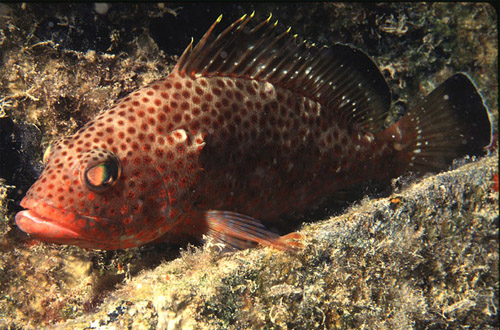
Parasites
Unidentified crab zoeae have been reported to infest the gills of a gray angelfish held in a trap.Predators
Trumpetfish (Aulostomus maculatus), red hind (Epinephelus gutatus), greater soapfish (Rypticus saponaceus), and yellowfin grouper (Mycteroperca venenosa) have been documented as containing blueheads in their stomach contents.
Taxonomy
The bluehead, a member of the wrasse family, was originally described as Labrus bifasciatus by German naturalist Marcus Bloch (1791). This original name was changed by later workers to the currently valid name of Thalassoma bifasciatum (Bloch, 1791). Synonyms used to refer to this fish in past scientific literature include Thalassoma nitida Gunther 1862 and Julis nitida Gunther 1862.
Prepared by: Cathleen Bester